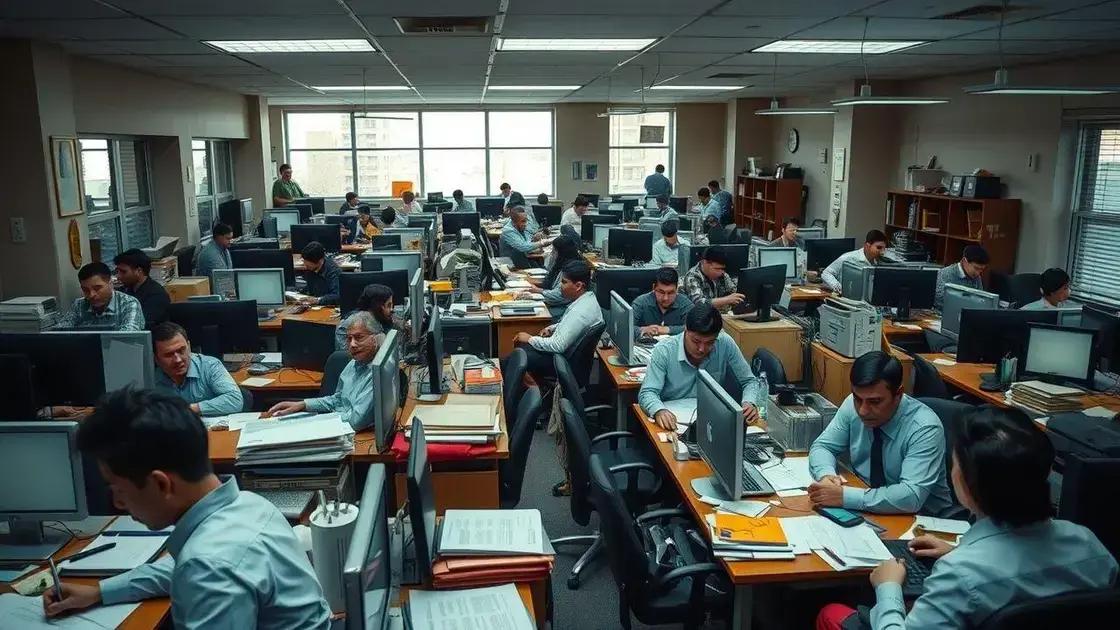Recent government agency staff insufficiencies impact efficiency

Recent government agency staff insufficiencies impact service delivery by leading to longer wait times, reduced quality of services, and increased employee burnout, necessitating strategic recruitment and retention efforts to enhance workforce effectiveness.
Recent government agency staff insufficiencies impact the ability of public services to operate efficiently. As these agencies face mounting pressures, how does that translate to the everyday experiences of citizens and employees alike?
Overview of government staffing challenges
In today’s world, government agencies face numerous challenges when it comes to staffing. These issues can significantly affect the delivery of services that citizens rely on. Understanding these staffing hurdles is essential for improving efficiency and effectiveness in the public sector.
Types of Staffing Challenges
The primary staffing challenges include recruitment difficulties, retention issues, and resource allocation problems. Each of these challenges can hinder the operational capacity of government agencies.
- Recruitment difficulties: Many agencies struggle to attract qualified candidates due to low pay and competition from the private sector.
- Retention issues: Once hired, employees may leave for better opportunities elsewhere, leading to a constant turnover.
- Resource allocation problems: Limited budgets can restrict agencies from hiring enough staff to meet their demands.
Moreover, these challenges are often compounded by changing regulations and increased public expectations. As the landscape shifts, agencies must navigate these complexities to maintain functionality.
Impact on Service Delivery
The impact of staffing shortages can be significant. Agencies may fail to respond promptly to public inquiries or processes may slow down. This can lead to a loss of trust among citizens and reduce the overall effectiveness of government services.
Addressing staffing challenges requires strategic planning and innovative solutions. For example, enhancing recruitment efforts through marketing and outreach can help attract talent. Training programs to develop existing employee skills can aid retention.
Moreover, leveraging technology can streamline processes and reduce staff workloads, making government roles more appealing. Ultimately, solving staffing challenges will enhance the relationship between citizens and their government.
Consequences of insufficient staffing
Insufficient staffing in government agencies can lead to various serious consequences. These consequences not only hinder the workforce but also impact the quality of service provided to the public. When there aren’t enough employees, workloads increase for everyone, which can result in burnout and lower morale.
Quality of Services Affected
One major consequence of insufficient staffing is a decline in service quality. Agencies may struggle to respond to inquiries promptly, leading to delays in important procedures. This can frustrate citizens who rely on timely assistance for various needs.
- Increased wait times: Citizens may experience longer wait times for services.
- Higher error rates: With fewer staff, the likelihood of mistakes increases.
- Decreased customer satisfaction: Public trust can erode if services are unreliable.
Moreover, when employees are stretched thin, they may prioritize speed over quality. This can lead to subpar outcomes, further complicating the situation.
Impact on Employee Well-Being
The pressure of insufficient staffing can also affect employee well-being. Constantly managing an overwhelming workload can lead to stress and dissatisfaction. As employees struggle to keep up, this can result in lower job performance and higher turnover rates.
When employees leave, the remaining staff must pick up the slack, creating a vicious cycle of overwork. It becomes increasingly challenging to maintain a healthy work-life balance. This environment not only affects the individuals but can also lead to a detrimental workplace culture.
Ultimately, understanding the consequences of insufficient staffing is crucial for government agencies. Identifying these challenges allows for strategic planning to improve staffing levels and restore efficiency and service quality.
Strategies for addressing staffing gaps

Addressing staffing gaps in government agencies is crucial to restore efficiency and improve service delivery. Various strategies can help organizations effectively tackle these challenges. Implementing the right approaches can not only fill current vacancies but also create a more sustainable workforce.
Enhanced Recruitment Efforts
One effective strategy is to enhance recruitment efforts. Agencies can utilize targeted marketing campaigns to attract qualified candidates. Promoting job openings through social media platforms, career fairs, and community outreach can broaden the pool of applicants.
- Networking events: Hosting or participating in career networking events helps agencies connect directly with potential candidates.
- Employee referrals: Encouraging current employees to refer candidates can yield high-quality applicants.
- Flexible job offerings: Providing part-time or remote work options can attract candidates who may not seek traditional job models.
These initiatives can significantly improve the visibility of job postings and attract a diverse range of applicants.
Improving Employee Retention
Another important strategy is to focus on employee retention. Keeping current employees satisfied is essential to reducing turnover and filling staffing gaps effectively. Agencies can implement regular feedback sessions, wellness initiatives, and training opportunities.
Investing in professional development shows employees that the organization values their growth. Offering competitive pay and benefits also plays a significant role in keeping talent in-house. When employees feel supported, they are less likely to seek opportunities elsewhere.
Moreover, creating a positive work environment can enhance overall morale. Celebrating achievements and fostering teamwork can make public service roles more appealing.
By employing these strategies, government agencies can better address staffing gaps and ensure they have the necessary resources to serve the public effectively.
Case studies from various agencies
Examining case studies from various government agencies provides valuable insights into how staffing challenges impact operations. These real-world examples highlight the creative solutions that organizations implement to overcome staffing insufficiencies.
Case Study 1: City Health Department
One city health department faced significant staffing shortages during a public health crisis. As the number of cases surged, the existing staff struggled to keep up with the demand for services. To address this, the department initiated a volunteer program, recruiting retired health professionals to assist in clinics.
- Outcome: This approach not only alleviated some pressure but also provided valuable experience to volunteers.
- Lesson Learned: Creative hiring solutions can tap into untapped resources while fostering community involvement.
Case Study 2: State Department of Motor Vehicles
In another instance, a state Department of Motor Vehicles (DMV) ran into long wait times due to insufficient staff. To combat this, they implemented an online appointment system and expanded their hours of operation.
The new system allowed customers to schedule visits, reducing overcrowding and improving the overall experience. Staff members received additional training on customer service to ensure efficiency.
- Outcome: Wait times decreased significantly, and customer satisfaction ratings improved.
- Lesson Learned: Embracing technology and optimizing service delivery can enhance agency performance.
These case studies illustrate the varying approaches agencies take to address staffing gaps. By learning from each other, government organizations can adopt best practices that suit their unique challenges.
Future outlook for government workforce
The future outlook for the government workforce is full of potential and challenges. As society evolves, so too do the needs and expectations of government agencies. Addressing staffing issues is essential for adapting to changing demands in public service.
Technological Integration
One significant aspect influencing the future workforce is the integration of technology. Automation and artificial intelligence (AI) are expected to streamline operations and reduce repetitive tasks. This shift may change the types of skills required from government employees.
- Emphasis on digital skills: As agencies adopt new technologies, training programs will need to focus on developing digital literacy among staff.
- AI as an assistant: AI tools can help employees analyze data and improve decision-making processes.
- Remote work opportunities: Technology facilitates remote work, which can attract a wider talent pool.
Preparing for these changes means investing in workforce development today to meet the demands of tomorrow.
Demographic Shifts
Another critical factor is the changing demographics within the workforce. As older generations retire, younger employees bring new expectations and perspectives. These shifts present both challenges and opportunities.
Government agencies must adapt to the values and work habits of newer generations, who often seek flexibility and meaningful work. Offering comprehensive benefits and opportunities for growth will be essential in attracting and retaining young talent.
Additionally, diversity and inclusion will become even more important. Agencies that embrace a diverse workforce will be better equipped to understand and serve their communities effectively.
By addressing these factors, government agencies can create a future workforce that is resilient, efficient, and well-prepared to meet the public’s needs.
Conclusion:
In summary, addressing recent government agency staff insufficiencies requires innovative solutions and a forward-thinking approach. As we explore the future outlook for the government workforce, it becomes clear that integrating technology, adapting to demographic shifts, and focusing on employee satisfaction are vital. By implementing these strategies, agencies can enhance their operations and better serve the public. A well-structured workforce will foster community trust and improve service delivery, ensuring a more effective government for all.
FAQ – Frequently Asked Questions about Staffing in Government Agencies
What are the main causes of staffing insufficiencies in government agencies?
Staffing insufficiencies can arise from budget constraints, high turnover rates, and the inability to attract qualified candidates.
How can technology help address staffing challenges?
Technology can streamline operations, automate repetitive tasks, and enhance recruitment efforts, making it easier to manage workloads.
What strategies can agencies implement to retain employees?
Agencies can offer competitive salaries, provide ongoing training, and create a positive work culture to improve employee retention.
Why is diversity important in the government workforce?
A diverse workforce enhances decision-making, reflects the community served, and fosters innovation and inclusivity in public service.





